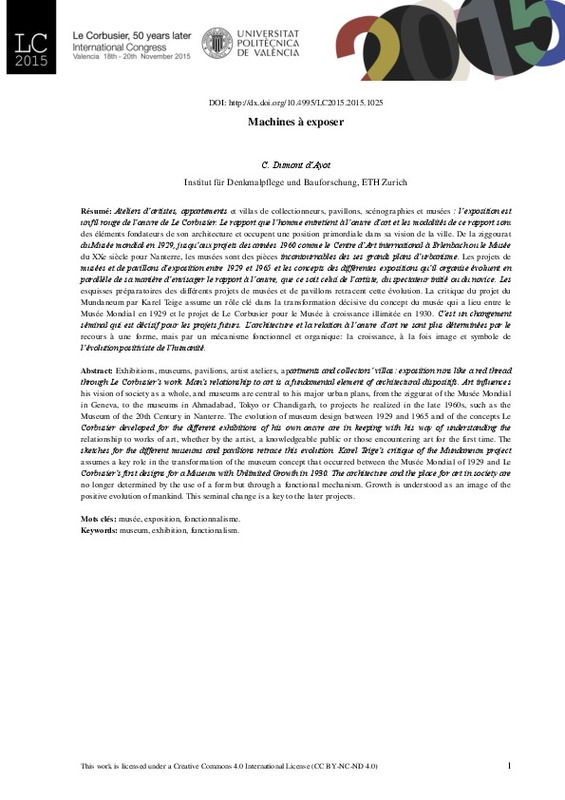JavaScript is disabled for your browser. Some features of this site may not work without it.
Buscar en RiuNet
Listar
Mi cuenta
Estadísticas
Ayuda RiuNet
Admin. UPV
Machines à exposer
Mostrar el registro sencillo del ítem
Ficheros en el ítem
| dc.contributor.author | Dumont d'Ayot, Catherine
|
es_ES |
| dc.date.accessioned | 2017-09-08T07:29:15Z | |
| dc.date.available | 2017-09-08T07:29:15Z | |
| dc.date.issued | 2016-03-03 | |
| dc.identifier.isbn | 9788490483732 | |
| dc.identifier.uri | http://hdl.handle.net/10251/86777 | |
| dc.description.abstract | [EN] Exhibitions, museums, pavilions, artist ateliers, apartments and collectors’ villas: exposition runs like a red thread through Le Corbusier’s work. Man’s relationship to art is a fundamental element of architectural dispositifs. Art influences his vision of society as a whole, and museums are central to his major urban plans, from the ziggurat of the Musée Mondial in Geneva, to the museums in Ahmadabad, Tokyo or Chandigarh, to projects he realized in the late 1960s, such as the Museum of the 20th Century in Nanterre. The evolution of museum design between 1929 and 1965 and of the concepts Le Corbusier developed for the different exhibitions of his own œuvre are in keeping with his way of understanding the relationship to works of art, whether by the artist, a knowledgeable public or those encountering art for the first time. The sketches for the different museums and pavilions retrace this evolution. Karel Teige’s critique of the Mundaneum project assumes a key role in the transformation of the museum concept that occurred between the Musée Mondial of 1929 and Le Corbusier’s first designs for a Museum with Unlimited Growth in 1930. The architecture and the place for art in society are no longer determined by the use of a form but through a functional mechanism. Growth is understood as an image of the positive evolution of mankind. This seminal change is a key to the later projects. | es_ES |
| dc.description.abstract | [FR] Exhibitions, museums, pavilions, artist ateliers, apartments and collectors’ villas: exposition runs like a red thread through Le Corbusier’s work. Man’s relationship to art is a fundamental element of architectural dispositifs. Art influences his vision of society as a whole, and museums are central to his major urban plans, from the ziggurat of the Musée Mondial in Geneva, to the museums in Ahmadabad, Tokyo or Chandigarh, to projects he realized in the late 1960s, such as the Museum of the 20th Century in Nanterre. The evolution of museum design between 1929 and 1965 and of the concepts Le Corbusier developed for the different exhibitions of his own œuvre are in keeping with his way of understanding the relationship to works of art, whether by the artist, a knowledgeable public or those encountering art for the first time. The sketches for the different museums and pavilions retrace this evolution. Karel Teige’s critique of the Mundaneum project assumes a key role in the transformation of the museum concept that occurred between the Musée Mondial of 1929 and Le Corbusier’s first designs for a Museum with Unlimited Growth in 1930. The architecture and the place for art in society are no longer determined by the use of a form but through a functional mechanism. Growth is understood as an image of the positive evolution of mankind. This seminal change is a key to the later projects. | es_ES |
| dc.language | Francés | es_ES |
| dc.publisher | Editorial Universitat Politècnica de València | es_ES |
| dc.relation.ispartof | LE CORBUSIER. 50 AÑOS DESPUÉS | es_ES |
| dc.rights | Reconocimiento - No comercial - Sin obra derivada (by-nc-nd) | es_ES |
| dc.subject | architecture | es_ES |
| dc.subject | le corbusier | es_ES |
| dc.subject | modern movement | es_ES |
| dc.title | Machines à exposer | es_ES |
| dc.type | Capítulo de libro | es_ES |
| dc.type | Comunicación en congreso | es_ES |
| dc.identifier.doi | 10.4995/LC2015.2015.1025 | |
| dc.rights.accessRights | Abierto | es_ES |
| dc.description.bibliographicCitation | Dumont D'ayot, C. (2016). Machines à exposer. En LE CORBUSIER. 50 AÑOS DESPUÉS. Editorial Universitat Politècnica de València. 578-600. https://doi.org/10.4995/LC2015.2015.1025 | es_ES |
| dc.description.accrualMethod | OCS | es_ES |
| dc.relation.conferencename | LC2015 - Le Corbusier, 50 years later | es_ES |
| dc.relation.conferencedate | November 18-20,2015 | es_ES |
| dc.relation.conferenceplace | Valencia, Spain | es_ES |
| dc.relation.publisherversion | http://ocs.editorial.upv.es/index.php/LC2015/LC2015/paper/view/1025 | es_ES |
| dc.description.upvformatpinicio | 578 | es_ES |
| dc.description.upvformatpfin | 600 | es_ES |
| dc.type.version | info:eu-repo/semantics/publishedVersion | es_ES |
| dc.relation.pasarela | OCS\1025 | es_ES |








